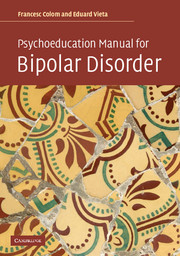Book contents
- Frontmatter
- Contents
- Foreword
- Preface
- Part 1 Clinical, diagnostic, and therapeutic aspects of bipolar disorders
- Part 2 Concept and methodology of psychoeducation
- Part 3 Psychoeducation program: sessions and contents
- Unit 1 Awareness of the disorder
- Session 1 Presentation and rules of the group
- Session 2 What is bipolar disorder?
- Session 3 Etiological and triggering factors
- Session 4 Symptoms I:Mania and hypomania
- Session 5 Symptoms II: Depression and mixed episodes
- Session 6 Evolution and prognosis
- Unit 2 Drug adherence
- Session 7 Treatment I: Mood stabilizers
- Session 8 Treatment II: Antimanic drugs
- Session 9 Treatment III: Antidepressants
- Session 10 Plasma levels of mood stabilizers
- Session 11 Pregnancy and genetic counseling
- Session 12 Psycho-pharmacology vs. alternative therapies
- Session 13 Risks associated with treatment withdrawal
- Unit 3 Avoiding substance abuse
- Session 14 Psychoactive substances: risks in bipolar disorders
- Unit 4 Early detection of new episodes
- Session 15 Early detection of mania and hypomanic episodes
- Session 16 Early detection of depressive and mixed episodes
- Session 17 What to do when a new phase is detected?
- Unit 5 Regular habits and stress management
- Session 18 Regularity of habits
- Session 19 Stress-control techniques
- Session 20 Problem-solving strategies
- Session 21 Closure
- Final note: Is psychoeducation efficacious?
- Bibliography
- Index
Unit 2 - Drug adherence
from Part 3 - Psychoeducation program: sessions and contents
Published online by Cambridge University Press: 06 January 2010
- Frontmatter
- Contents
- Foreword
- Preface
- Part 1 Clinical, diagnostic, and therapeutic aspects of bipolar disorders
- Part 2 Concept and methodology of psychoeducation
- Part 3 Psychoeducation program: sessions and contents
- Unit 1 Awareness of the disorder
- Session 1 Presentation and rules of the group
- Session 2 What is bipolar disorder?
- Session 3 Etiological and triggering factors
- Session 4 Symptoms I:Mania and hypomania
- Session 5 Symptoms II: Depression and mixed episodes
- Session 6 Evolution and prognosis
- Unit 2 Drug adherence
- Session 7 Treatment I: Mood stabilizers
- Session 8 Treatment II: Antimanic drugs
- Session 9 Treatment III: Antidepressants
- Session 10 Plasma levels of mood stabilizers
- Session 11 Pregnancy and genetic counseling
- Session 12 Psycho-pharmacology vs. alternative therapies
- Session 13 Risks associated with treatment withdrawal
- Unit 3 Avoiding substance abuse
- Session 14 Psychoactive substances: risks in bipolar disorders
- Unit 4 Early detection of new episodes
- Session 15 Early detection of mania and hypomanic episodes
- Session 16 Early detection of depressive and mixed episodes
- Session 17 What to do when a new phase is detected?
- Unit 5 Regular habits and stress management
- Session 18 Regularity of habits
- Session 19 Stress-control techniques
- Session 20 Problem-solving strategies
- Session 21 Closure
- Final note: Is psychoeducation efficacious?
- Bibliography
- Index
Summary
Improving treatment adherence must be one of the main objectives of any psychological intervention in bipolar disorders, since the problem of poor adherence is certainly the cornerstone of the poor evolution of many of our patients. The problem is severe if we consider that practically all bipolar patients seriously think at least once in their life of abandoning treatment, and it is not risky to affirm that more than half the patients stop taking the prescribed treatment without indication from their psychiatrists, even including during periods of euthymia. On the other hand, treatment withdrawal is the most common cause of relapse among bipolar patients and in fact, the risk of hospitalization is four times higher among the patients who do not duly comply with their maintenance treatment. Mortality, especially by suicide, is also higher in untreated patients. These considerations, along with the high rates of poor adherence recorded in bipolar populations, force us to make a great effort to improve our patients’ adherence to treatment. This effort makes it appropriate for us to dedicate up to seven sessions to this topic in our program.
As we can see in Chart 1, when speaking of poor adherence we are not only referring to the patient who does not take his medication. Broadly, we can affirm that by poor adherence we understand that inability of the patient to follow some or all of the instructions given by his psychiatrist and psychologist, including drug prescription and the facilitation of health-promoting behavior or habits.
- Type
- Chapter
- Information
- Psychoeducation Manual for Bipolar Disorder , pp. 104 - 110Publisher: Cambridge University PressPrint publication year: 2006

